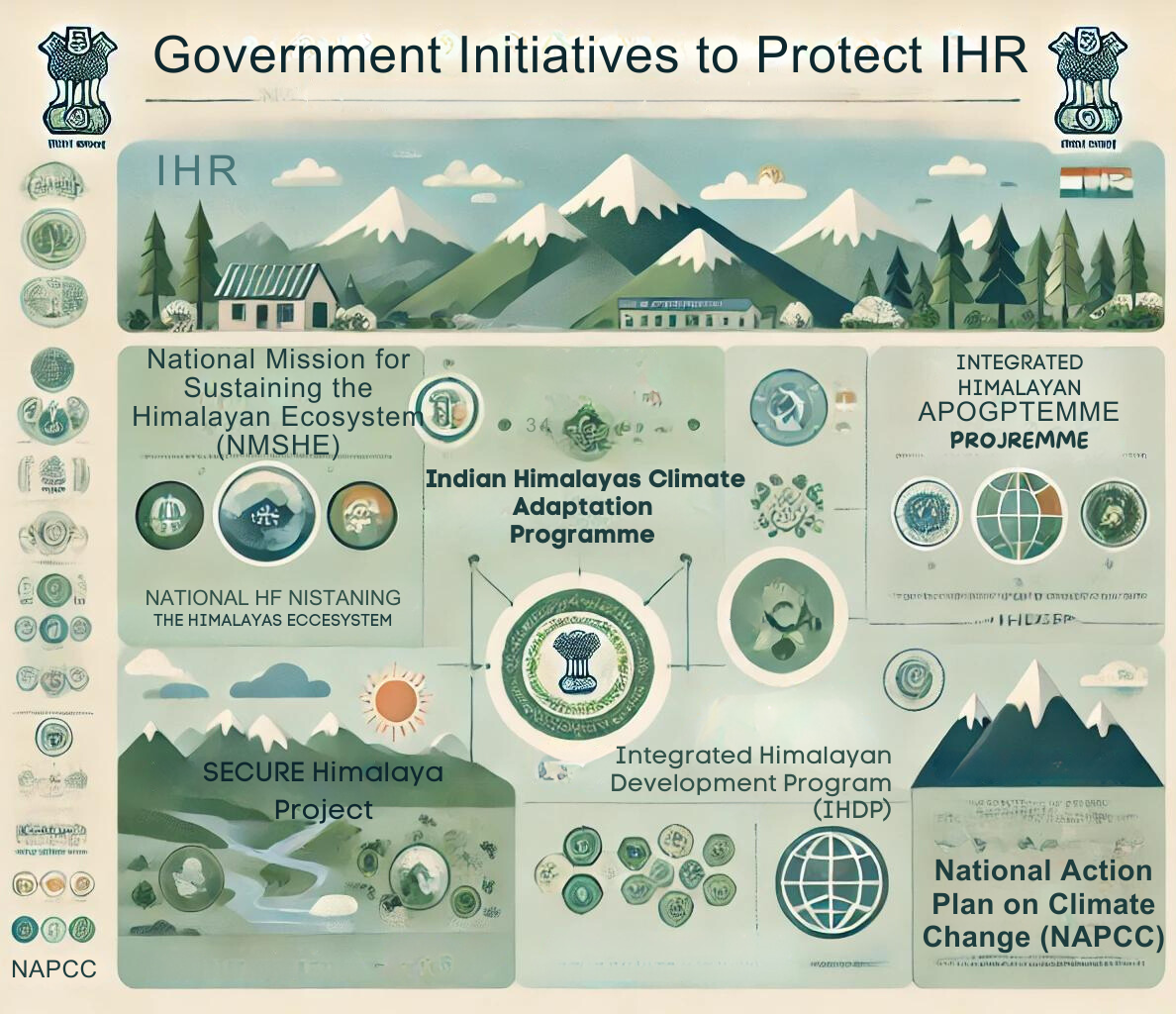The Indian Himalayan Region (IHR) faces critical environmental issues that threaten its unique ecosystem and the well-being of local communities. The recent Supreme Court order, recognizing the right to be free from the adverse effects of climate change, provides a significant step towards sustainable development in the IHR. This editorial discusses the environmental challenges in the IHR and suggests measures to align development with ecological sustainability.
Origin of the Article
This editorial is based on “The Supreme Court of India spells the way in Himalaya’s development” published in The Hindu on June 25, 2024. The article discusses environmental issues in the Indian Himalayan Region (IHR) and sustainable development methods in light of a recent Supreme Court order.
Relevancy for UPSC Students
Understanding the environmental challenges and sustainable practices in the IHR is crucial for UPSC aspirants. This topic is relevant to the GS Paper 3 syllabus, covering environmental pollution, degradation, and impact assessment. It provides insights into sustainable development, crucial for both the prelims and mains examinations.

Why in News
The Indian Himalayan Region (IHR) is in the spotlight due to a recent Supreme Court order recognizing the right to be free from adverse climate change effects, emphasizing sustainable development. This is crucial for UPSC aspirants as it connects with previous questions on environmental conservation, climate change, and sustainable development, highlighting the judiciary’s role in ecological preservation.
The Indian Himalayan Region (IHR)
The Indian Himalayan Region (IHR) spans over 2500 km and includes 13 Indian States/Union Territories. This mountainous area is characterized by its unique development needs, geographical significance, and challenges. It serves as a crucial ecological and hydrological zone, playing a pivotal role in India’s environmental balance and cultural diversity.
About
The IHR refers to the vast mountainous area in India, encompassing the entire Himalayan range within the country. It spans 13 Indian States and Union Territories, including Jammu and Kashmir, Ladakh, Uttarakhand, Himachal Pradesh, Arunachal Pradesh, and others, covering a length of 2500 km.
Significance
The IHR is home to some of the world’s highest peaks, such as Kanchenjunga, and is known as India’s “water tower” for its role in feeding major rivers like the Ganges and Yamuna. It maintains ecological balance, supports biodiversity, and influences climate patterns. The region also holds significant cultural, religious, and strategic importance.
Key Environmental Concerns in the Indian Himalayan Region
The Indian Himalayan Region faces numerous environmental challenges that threaten its ecosystem and inhabitants. Climate change, glacial melting, soil erosion, water scarcity, pollution, and unplanned developmental projects are some of the critical issues. These concerns exacerbate natural disasters and impact the region’s overall sustainability.
Climate Change and Glacial Melting
Global warming is causing rapid melting of Himalayan glaciers, affecting water resources and increasing natural disasters like flash floods and Glacial Lake Outburst Floods (GLOFs). The Gangotri Glacier has retreated significantly, and events like the Kedarnath disaster highlight the severe impacts of glacial melting.
Soil Erosion and Landslides
Deforestation, unplanned construction, and overgrazing contribute to severe soil erosion and landslides in the IHR. The monsoon season exacerbates these issues, leading to significant loss of life and property, as seen in the 2021 Chamoli landslide disaster.
Water Scarcity and Pollution
Water scarcity is prevalent in many areas of the IHR due to drying springs and streams. Pollution from agricultural runoff, untreated sewage, and industrial effluents contaminates water sources, affecting both human health and ecosystems, as highlighted by a Central Ground Water Board study.
Developmental Projects
Infrastructure and hydroelectric projects disrupt river ecosystems and displace local communities. The National Disaster Management Authority (NDMA) has identified illegal construction as a major factor in exacerbating flood risks, as seen in the 2023 Himachal Pradesh floods.
Air Pollution
Air pollution in the IHR is rising due to vehicular emissions, industrial activities, and biomass burning. The mountainous terrain traps pollutants, leading to health issues and reduced visibility. Leh in Ladakh has experienced significant air quality deterioration due to increased traffic and construction.
Deforestation and Habitat Loss
The IHR’s rich biodiversity is threatened by large-scale deforestation for agriculture and urban development. The State of Forest Report, 2021, recorded a significant decline in forest cover, especially in Himalayan states, leading to habitat loss and endangerment of species.
Recent Supreme Court Judgments Supporting Environmental Conservation Efforts in the IHR
Recent Supreme Court judgments have reinforced environmental conservation in the IHR by recognizing the right against climate change and advocating for an ecocentric view of the environment. These rulings emphasize the need for sustainable development aligned with environmental protection.
Recognition of the Right against Climate Change
In the case of M K Ranjitsinh & Ors. v. Union of India, the Supreme Court recognized the right to be protected from adverse climate change under Articles 14 and 21 of the Constitution. This landmark ruling underscores the government’s obligation to implement effective measures to safeguard environmental and human rights.
To Adopt an Ecocentric View of the Environment
The Supreme Court, in State of Telangana vs Mohd. Abdul Qasim emphasized the need for an ecocentric approach to environmental protection. The Court urged mankind to act as trustees of the Earth and to live sustainably, respecting the rights of natural entities like rivers, trees, and mountains.
Directions on the Carrying Capacity of the Himalayan States
In the PIL Ashok Kumar Raghav vs Union of India, the Supreme Court directed the government to consider the carrying capacity of Himalayan states. This directive aims to balance development with environmental sustainability, ensuring that the region’s ecological health is not compromised.
Government Initiatives to Protect IHR
The government has launched various initiatives to protect and sustain the IHR, focusing on biodiversity conservation and climate resilience. These efforts aim to address the unique environmental challenges of the region and promote sustainable development.

National Mission for Sustaining the Himalayan Ecosystem (NMSHE)
NMSHE aims to address climate change impacts, promote sustainable livelihoods, and conserve biodiversity in the IHR. It focuses on developing strategies to mitigate the adverse effects of climate change and ensure the sustainability of the region’s ecosystems.
Indian Himalayas Climate Adaptation Programme (IHCAP)
IHCAP focuses on building climate resilience in the IHR through adaptation initiatives. It aims to enhance the region’s capacity to cope with climate variability and promote sustainable development practices that protect both the environment and local communities.
SECURE Himalaya Project
The SECURE Himalaya Project aims to conserve biodiversity and promote sustainable development in the IHR. It involves activities like habitat restoration, community-based conservation, and sustainable livelihood initiatives to ensure the long-term health of the region’s ecosystems.
Integrated Himalayan Development Program (IHDP)
IHDP promotes integrated development in the IHR, focusing on sustainability. It aims to balance economic growth with environmental protection, ensuring that development projects do not harm the region’s ecological balance or biodiversity.
National Action Plan on Climate Change (NAPCC)
The NAPCC outlines a national strategy to address climate change, with specific measures for the IHR. It includes initiatives for climate adaptation, sustainable agriculture, water resource management, and forest conservation, aiming to build a resilient and sustainable future for the region.
PESTEL Analysis
| Political: The Indian Himalayan Region (IHR) is politically sensitive due to its strategic borders and diverse governance across 13 states and union territories. Government initiatives like the National Mission for Sustaining the Himalayan Ecosystem and the Indian Himalayas Climate Adaptation Programme play crucial roles. Recent Supreme Court rulings emphasize an ecocentric view and the rights against adverse climate effects, reinforcing the political will for sustainable policies. Economic: The IHR’s economy is predominantly based on agriculture, tourism, and hydroelectric projects. While these sectors contribute significantly to the region’s and nation’s economy, they also pose threats to its ecological balance. Sustainable development challenges include balancing economic gains with environmental sustainability, promoting eco-friendly tourism, and sustainable agricultural practices. Social: The diverse ethnic communities in the IHR depend heavily on its natural resources for livelihood. Social challenges involve managing the impact of migration, urbanization, and changing socio-economic dynamics, which affect traditional practices and the social fabric. Education and awareness about sustainable practices are vital for community participation in conservation efforts. Technological: Technological interventions are needed for climate-resilient infrastructure and environmental monitoring. Innovations such as rainwater harvesting technologies, eco-friendly construction practices, and sustainable energy solutions like micro-hydropower projects can support sustainable development goals. Environmental: Key environmental challenges include climate change and its impact on glaciers, water scarcity, soil erosion, and biodiversity loss due to deforestation and habitat destruction. A robust environmental policy framework is required to address these issues, focusing on conservation, reforestation, and sustainable land and water resource management. Legal: Legal frameworks support environmental conservation, with the Supreme Court’s directives serving as a benchmark for enforcing sustainable development laws. Legal provisions need to ensure compliance with environmental norms in developmental projects and protect the rights of indigenous populations against the ecological impacts of development. |
Measures to Promote Sustainable Development in the IHR
Promoting sustainable development in the IHR requires strategies that enhance climate resilience, conserve biodiversity, and support local communities. Implementing these measures can ensure the long-term ecological and economic health of the region.
Climate-Resilient Infrastructure
Adopting building codes and green infrastructure practices can make structures resilient to natural disasters. The Mishra Committee’s recommendation to ban construction in disaster-prone areas is crucial for reducing risks and enhancing safety in the IHR.
Integrated Land Use Planning
Developing comprehensive land use plans using GIS and remote sensing can help balance conservation and development. The Gadgil Committee’s zoning system for the Western Ghats serves as a model for sustainable land use planning in the IHR.
Water Resource Management
Effective water resource management in the IHR involves promoting rainwater harvesting and springshed management. The NGRBA’s approach to rejuvenating the Ganga River highlights the importance of sustainable practices in addressing water scarcity and pollution.
Forest and Biodiversity Conservation
Large-scale reforestation and community management programs can restore degraded lands and enhance biodiversity. Initiatives like the Chipko Movement demonstrate the power of local communities in protecting forest resources and promote conservation.
Sustainable Agriculture
Encouraging organic farming, micro-hydropower projects, and agroforestry can promote sustainable agriculture in the IHR. Sikkim’s success as a fully organic state showcases the benefits of reducing chemical inputs and enhancing soil health.
Eco-Friendly Tourism
Regulating tourism through carrying capacity assessments and promoting eco-tourism can minimize environmental impact. The NDMA’s regulations for GLOF-prone areas highlight the need for sustainable tourism practices to protect the IHR’s fragile environment.
Monitoring and Research
Establishing robust environmental monitoring systems and supporting research initiatives are essential for sustainable development. The HLEG’s report on Himalayan Glaciology emphasizes the importance of monitoring glaciers and understanding their role in regional water resources.
Education and Awareness
Incorporating environmental education into school curricula and raising community awareness can foster environmental stewardship. Teaching students about the geology and ecology of the Himalayas can create a sense of connection and responsibility toward protecting the region.
Conclusion
In light of recent Supreme Court rulings and the recognition of the fundamental right to be protected from the adverse effects of climate change, it is imperative that people, especially those in the Indian Himalayan Region (IHR), are entitled to a sustainable development model that aligns with the region’s ecological carrying capacity. The path forward should safeguard the environment and ensure the long-term prosperity and well-being of communities in the IHR, emphasizing a balance between development and environmental sustainability.
| UPSC Civil Services Examination, Previous Year Questions (PYQs) Mains Q. The states of Jammu and Kashmir, Himachal Pradesh, and Uttarakhand are reaching the limits of their ecological carrying capacity due to tourism. Critically evaluate. (GS-III, 2015) Q. Analyze the role of the National Mission for Sustaining the Himalayan Ecosystem (NMSHE) and the Indian Himalayas Climate Adaptation Programme (IHCAP) in addressing the challenges posed by climate change in the Indian Himalayan Region. |


